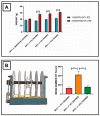Effects of Different Continuous Aerobic Training Protocols in a Heterozygous Mouse Model of Niemann-Pick Type C Disease
- PMID: 33467268
- PMCID: PMC7739240
- DOI: 10.3390/jfmk5030053
Effects of Different Continuous Aerobic Training Protocols in a Heterozygous Mouse Model of Niemann-Pick Type C Disease
Abstract
The positive effects of physical activity on cognitive functions are widely known. Aerobic training is known to promote the expression of neurotrophins, thus inducing an increase in the development and survival of neurons, as well as enhancing synaptic plasticity. Based on this evidence, in the present study, we analyze the effects of two different types of aerobic training, progressive continuous (PC) and varying continuous (VC), on synaptic and muscular plasticity in heterozygous mice carrying the genetic mutation for Niemann-Pick type C disease. We also analyze the effects on synaptic plasticity by extracellular recordings in vitro in mouse hippocampal slices, while the morphological structure of muscle tissue was studied by transmission electron microscopy. Our results show a modulation of synaptic plasticity that varies according to the type of training protocol used, and only the VC protocol administered twice a week, has a significantly positive effect on long-term potentiation. On the contrary, ultrastructural analysis of muscle tissue shows an improvement in cellular conditions in all trained mice. These results confirm the beneficial effects of exercise on quality of life, supporting the hypothesis that physical activity could represent an alternative therapeutic strategy for patients with Niemann-Pick type C disease.
Keywords: Niemann-Pick type C disease; aerobic training; mouse model; muscle plasticity; neurodegeneration; synaptic plasticity.
Conflict of interest statement
The authors declare no conflict of interest.
Figures



Similar articles
-
Hippocampal Adaptations to Continuous Aerobic Training: A Functional and Ultrastructural Evaluation in a Young Murine Model.J Funct Morphol Kinesiol. 2021 Dec 8;6(4):101. doi: 10.3390/jfmk6040101. J Funct Morphol Kinesiol. 2021. PMID: 34940510 Free PMC article.
-
Effects of short-term aerobic exercise in a mouse model of Niemann-Pick type C disease on synaptic and muscle plasticity.Ann Ist Super Sanita. 2019 Oct-Dec;55(4):330-337. doi: 10.4415/ANN_19_04_05. Ann Ist Super Sanita. 2019. PMID: 31850859
-
Modulation of synaptic plasticity by short-term aerobic exercise in adult mice.Behav Brain Res. 2017 Aug 14;332:59-63. doi: 10.1016/j.bbr.2017.05.058. Epub 2017 May 27. Behav Brain Res. 2017. PMID: 28559180
-
Understanding Niemann-Pick type C disease: a fat problem.Curr Opin Neurol. 2003 Apr;16(2):155-61. doi: 10.1097/01.wco.0000063764.15877.1c. Curr Opin Neurol. 2003. PMID: 12644742 Review.
-
Finding pathogenic commonalities between Niemann-Pick type C and other lysosomal storage disorders: Opportunities for shared therapeutic interventions.Biochim Biophys Acta Mol Basis Dis. 2020 Oct 1;1866(10):165875. doi: 10.1016/j.bbadis.2020.165875. Epub 2020 Jun 6. Biochim Biophys Acta Mol Basis Dis. 2020. PMID: 32522631 Review.
Cited by
-
Hippocampal Adaptations to Continuous Aerobic Training: A Functional and Ultrastructural Evaluation in a Young Murine Model.J Funct Morphol Kinesiol. 2021 Dec 8;6(4):101. doi: 10.3390/jfmk6040101. J Funct Morphol Kinesiol. 2021. PMID: 34940510 Free PMC article.
-
Dose-Response Effect of Vibratory Stimulus on Synaptic and Muscle Plasticity in a Middle-Aged Murine Model.Front Physiol. 2021 Jun 11;12:678449. doi: 10.3389/fphys.2021.678449. eCollection 2021. Front Physiol. 2021. PMID: 34177622 Free PMC article.
-
Neurodegeneration in Niemann-Pick Type C Disease: An Updated Review on Pharmacological and Non-Pharmacological Approaches to Counteract Brain and Cognitive Impairment.Int J Mol Sci. 2021 Jun 20;22(12):6600. doi: 10.3390/ijms22126600. Int J Mol Sci. 2021. PMID: 34202978 Free PMC article. Review.
-
Aerobic Exercise Induces Alternative Splicing of Neurexins in Frontal Cortex.J Funct Morphol Kinesiol. 2021 May 31;6(2):48. doi: 10.3390/jfmk6020048. J Funct Morphol Kinesiol. 2021. PMID: 34072692 Free PMC article.
References
-
- Sawamura N., Gong J.S., Garver W.S., Heidenreich R.A., Ninomiya H., Ohno K., Yanagisawa K., Michikawa M. Site-specific Phosphorylation of Tau Accompanied by Activation of Mitogen-Activated Protein Kinase (MAPK) in Brains of Niemann-Pick Type C Mice. J. Biol. Chem. 2001;276:10314–10319. doi: 10.1074/jbc.M009733200. - DOI - PubMed
Grants and funding
LinkOut - more resources
Full Text Sources

